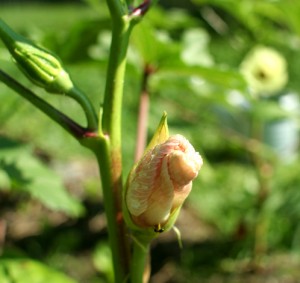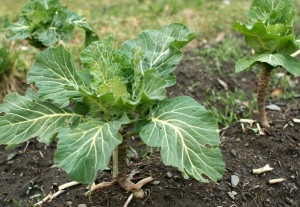Growing Heat-Loving Vegetables in the North

An okra flower
I decided to plant okra in the garden this summer because I love all the cuisines that use it: Indian, Middle Eastern, Southern U.S, plus Mediterranean and Caribbean (and there are probably others). I’ve eaten it prepared different ways in restaurants but, before this summer, had cooked it just once at home. My plan was to grow lots of it and then become adept at preparing it different ways.
What do all of these cuisines have in common? They all originate in a warm climate. If this was not enough to deter me, you’d think these two characteristics of okra, of which I was fully aware, would have kept me from trying to grow it: okra does not like temperatures below 45 or 50°F and doesn’t like to be transplanted, eliminating the usual solution of using starters to extend Vermont’s short growing season.
Another lesson I learned, which I suggest to anyone planning to grow okra, is to plant a fair number of plants—a dozen at least. I had six plants and found that I never had enough okra to make a dish. Because okra toughens when allowed to grow too large—they should be picked when they’re about 4 inches in length—I made an effort to pick them almost daily. The problem is that there would only be a few ready to pick at any given time. By the time I’d accumulated enough for a dish, the first okra I’d picked would no longer be fresh. That was when I realized I would need to blanch and freeze as I picked.
Though my okra yield wasn’t enough to enable me to become adept at making okra every which way, the plants themselves were worth the effort. When the okra plant is mature enough to produce fruit, a pale peach-colored bud will appear. That is followed by a large pale-yellow flower with a deep yellow and burgundy stamen. Seeing these beautiful and exotic-looking flowers in my vegetable garden was an unexpected pleasure. Even if you don’t like okra, you might consider growing the plants just for their blossoms, and give the okra to a friend who likes it.

An okra blossom and an immature okra pod (upper, left)

An okra flower, looking ready to hit the streets, and an okra blossom, in the foreground
I’ve discovered that not all vegetables associated with Southern cooking or other warm climates fare poorly in the North, or take lots of work to successfully grow. Collards are one example. They’re easy to grow and are heartier than Swiss chard. In fact, they sweeten after the first frost. This photograph of collards was taken on December 2, just before picking them for a very, very late fall harvest. Compare this photo with the one of the dead okra plants taken on the same day. (The okra, by the way, has been looking fully dead for quite some time now.)

Collards in early December

Okra in early December, no longer looking so beautiful.
